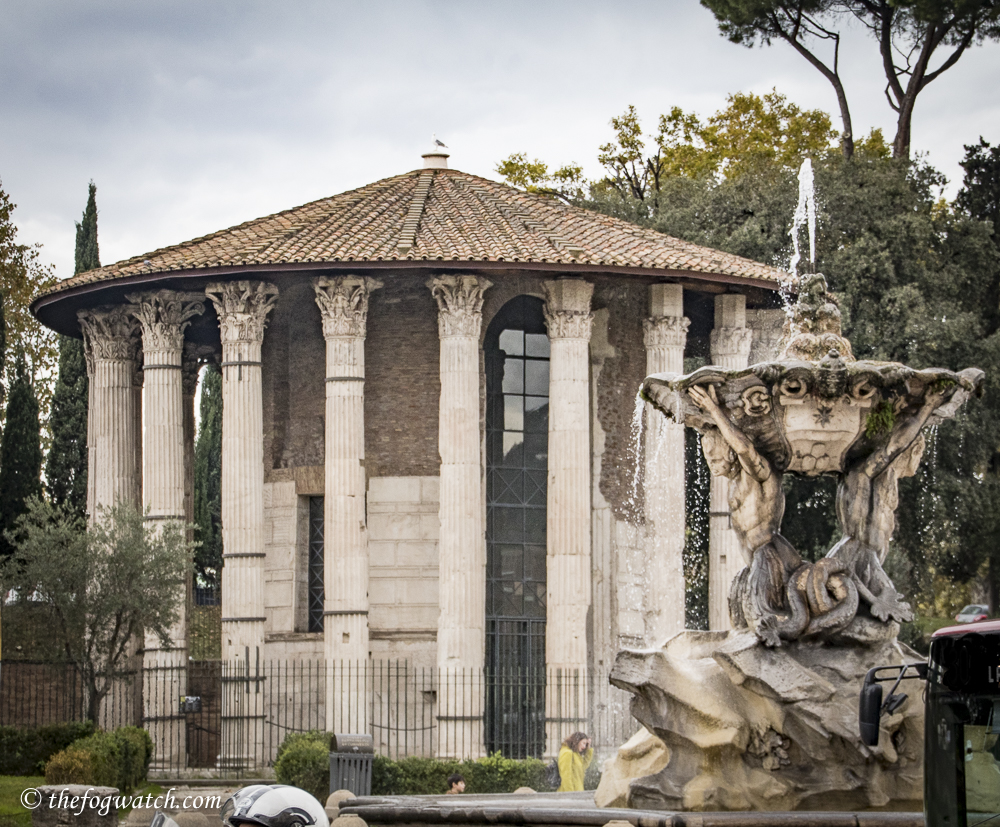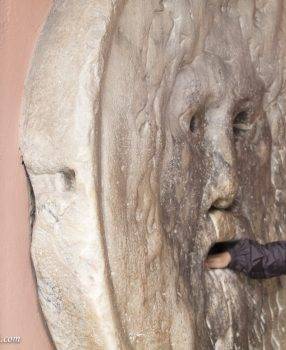The Bocca della Verità is a bit special. In the absence of a handy lie detector, how do you know if someone is being truthful? Trial by ordeal? Convince people that the gods know if you’re being truthful? How could that work? To find out, we need to go to Rome…

Hanging on the wall in the portico of the Basilica di Santa Maria in Cosmedin, at the Piazza della Bocca della Verità — which is named after a large marble mask called —literally— the Mouth of Truth. This was a truth test. In medieval times an accused person would put their hand in the mouth of the mask, and if they lied, the mask would bite off their hand. In reality, it is said that an axeman stood concealed behind the mask, likely waiting for a hidden signal. Perhaps in those days, truth depended on how large a bag of coins was slipped into the mouth beforehand…

The mask itself is impressive — it is a marble disk about 1.75m (5’9”) in diameter weighing more than a tonne. It is shaped as a face, possibly of Oceanus (god of the sea) with a gaping mouth, wide nostrils and open eyes. I took the plunge and placed my hand in. The mouth is at a convenient height and the lower lip has been worn smooth with the countless hands that have reached for the truth. Yes, I used hand sanitizer afterwards — the truth can be sticky after all. The church is also said to hold the skull of St Valentine, so perhaps it also attracts lovers wanting to see if their love is true.
On Truth
Of course, the nature of truth has been debated by philosophers for millenia, but is generally considered to refer to statements that correspond to reality. Perhaps politicians need to submit themselves to a mouth of truth! The issue then and now relates to accountability for one’s actions. And whether truth is certified by faith in a technology that measures brain patterns or skin conductivity, or by faith in an all-seeing, all-knowing deity, ultimately it comes down to the integrity of the individual, hopefully without the need to resort to an external gurantor of truth.
As to faith in truth technology, I heard a delightful story when I visited the Solomon Islands some years ago. It was not too long after the 2000 coup, and I spoke with a member of the International Peace Monitoring Team who was going from village to village to certify that they had handed over all their weapons to the international observers.
The village Chief was asked to sign an official certificate to that effect during a signing ceremony. But as this inspector handed the Chief a pen — which had a digital alarm clock built in — the Chief was told that the pen had special truth-detecting technology and would sound a beep if they signed a lie. And to prove it, he would set the timer for 30 seconds and then say that their name was something else, whereupon the pen would beep… There were several occasions where the chief would ask for another day or two while they made sure and handed over some more weapons that had been kept aside, before signing the paper. Such is the power of faith.
Temple of Hercules Victor
The Mouth of Truth itself dates back to the 1st Century CE. It was originally associated with the temple of Hercules Victor at the ancient cattle market (the Forum Boarium). And there are several theories as to the mask’s original purpose. Perhaps it was used as an opening in the altar to capture the blood of cattle sacrificed at the temple. Ultimately, it was moved to the Basilica of Santa Maria in the 13th Century.

The temple of Hercules Victor is the earliest intact surviving marble building from ancient Rome. It dates from the 2nd Century BCE. Like several ancient buildings, it survived, due to its conversion to a Christian church. It is now the church of Santo Stefano della Carozze (St. Stephen ‘of the carriages’) consecrated around 1140 CE.
The circular temple is built in the Greek style from travertine and marble blocks. Nineteen of the original twenty columns still survive. Its latest restoration was completed in 1996.


The mouth of truth ! From the Roman Holiday Movie !
Yes it was used in that movie — of course predating it by a loooong time!
Love this but there’s something troubling about what might be read as a form of colonialist dominance vis-a-vis technology, “pulling one over” on a Village Chief. It’s odd and reminds me of Spivak’s subaltern. In other words, perhaps, The Face of Truth – but whose truth?
Thanks Alan — yes it’s a complex issue here, as I agree that there is a troubling colonialism attached to that. On the other hand, in the absence of other means of verifying, I can see that the IPMT team leader had a pragmatic issue of ensuring a safer peace under the terms agreed to by the warring factions, primarily between the Malaitans and the Gualese rebels. At that time renewed armed conflict still remained a live possibility so the peace process relied on containment of the weapons to prevent further bloodshed. Indeed, only a couple of months later there was an incident in which IPMT team members from the international community were fired upon by an armed Gualese person. I guess it would have been a balance between relying on the force of a Christian concept of an omnipresent god — itself a colonialist overlay — or work with their belief in Western technology (there were still active cargo cults from WWII in the area). Considering the enormous quantity of WWII live ammunition still lying around, I’m guessing that the team leader made their calculus based on the ability to fire such ammunition, and went with a pragmatic, if unorthodox, method of persuasion.
This is a great article.. on reading, it feels as if the reader is there, observing it all. Well done, and thanks for sharing.
Many thanks Beth 🙂